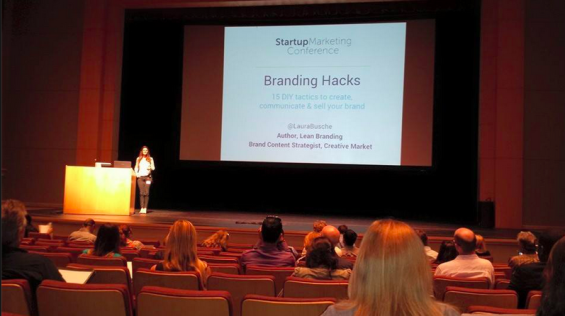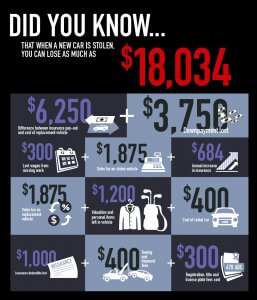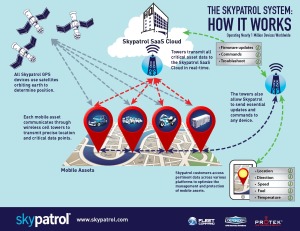Content Marketing
Warning: Undefined variable $author_id in /srv/users/peakseven/apps/staging/public/wp-content/themes/p7-theme/partials/posts.php on line 26
steve
June 26, 2019
From scrolling down your twitter feed to a stroll through the mall, it’s easy to see that this year’s Pride is in full swing. The month-long LGBT+ celebration is a beautiful conglomeration of activism, history, parties, and even marketing? Brands promoting gay pride publicly was unheard 50 years ago (Which is when the historic Stonewall Riots occurred, leading the way for the modern gay pride movement.) However, now in our more socially-minded society, consumers care a lot more how a large brand impacts the world and it’s culture. With an increase in brands riding the inclusivity wave, it calls into question, does featuring and celebrating LGBT+ Pride positively or negatively impact consumer demand?
Inclusivity Marketing is creating content that truly reflects the diverse communities that your company serves. We have seen this in various movements from the #bodypositivity movement to #aeriereal campaign. Which shows models of all shapes and sizes flourishing in underwear ads. Brands are realizing marketing to every kind of person may be the way to attract new customers. Creating campaigns that showcase real people not just photoshopped models. Which allows more marginalized groups a chance to really connect with that brand, creating brand loyalty. An even simpler reason, is targeting a wider range of people equates to plainly, more eyes on your products. This more inclusive marketing trend combined with the Pride celebration’s continued growth. Means the month of June is the perfect showcase for large-scale inclusivity marketing. A mix of companies using their platform for good and some wanting to make money off of marginalized groups leaves a mixed-bag of interesting campaigns that are worth analyzing.
2019 Pride Content Examples
- Adidas – Released a Pride collection entitled “Pride pack”. Though not tied to product sales, Adidas will be supporting The Trevor Project, the world’s largest suicide prevention and crisis intervention organization for the youth of the community.

- Absolut Vodka – Using a myriad of LGBT+ influencers, Absolut Vodka is kicking off a campaign with multiple channels, including commercials, branded events during Pride weekend, and in addition to bringing back its iconic rainbow bottle, Absolut has launched a multi-year partnership supporting GLAAD’s work accelerating acceptance for the LGBT community.

- Victoria Secret- Their brand Pink, tweeted their support for Pride month where they state that they will donate 100K to a LGBTQ+ Organization, the brand is still facing scrutiny over anti-trans comments made earlier this year.
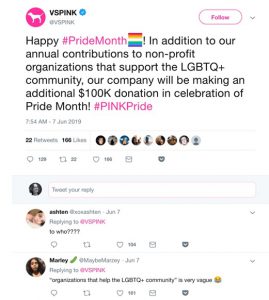
- Gap – Launched its “Love all ways” campaign highlighting what family means today and will donate 15% of proceeds to the U.N. Free and Equal Foundation.

- American Express – Is celebrating Pride with a performance by Singer Lizzo. All proceeds will go to the Stonewall Community Foundation, an organization that bears part of its historic name to honor the 1969 uprising that started in New York and the spirit of freedom, resilience, and resolve that abides today. American Express is also displaying an array of Pride-themed ads over New York with messages of Pride and acceptance.
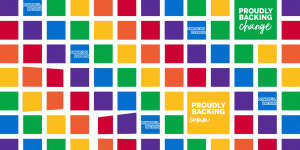
These are just some of the examples of what companies do during the month of June. What Makes them successful or scrutinized all depends on context.
How These Campaigns Were Received
Campaigns run by Absolut Vodka, Gap, and American Express have three things in common, that made their Pride campaigns successful. First, their brands support the LGBT+ Community throughout the year, not just in June. They do this with continued donations (American Express) and inclusive marketing (Gap and Absolut Vodka). Two, they specifically call out where they are donating their money, instead of just vaguely stating they are supporting the community. This makes the campaign seem more genuine. Lastly the pride/rainbow items they are selling are completely or in-part not for profit. The transparency demonstrated by these brands isn’t just a new fad.
Regan Clarke, Brand Director of Absolut Vodka, USA knows exactly where his brand belongs in all of this and is proud of it. Stating “Supporting the LGBTQ community back in 1981 was a risky decision for mainstream brands, when taking a stand for equality meant going against conventional culture.” Absolut’s 30+ year commitment to Pride is a great example of how inclusive marketing, can work and has worked. Demonstrating how powerful, socially aware marketing really can be when trying to further your brands position and satisfy younger consumers. These brands are creating an image for themselves as a positive presence in the world. Brand directors like Regan Clarke, show how putting time and effort into a pride campaign can really yield positive returns.
On the opposite spectrum is Victoria Secret. Earlier this year they had a major scandal involving their CMO Ed Razek. When he claimed transgender people don’t belong in the “coveted” Victoria Secret fashion show, because they don’t represent fantasy. “Dear Victoria’s Secret, you said trans women can’t sell the “fantasy” so here I am as a TRANS WOMAN selling the FANTASY! ماهي لعبة الروليت ” wrote trans makeup mogul, Nikita Dragun on her Twitter account in the weeks following the 2018 fashion show disaster. Fans were quick to bring Dragun’s tweet up again when Victoria’s Secret attempted to voice support for the LGBTQ+ community during pride month (The Tweet above). Showing how consumers are quick to call out inconsistency and injustice within a brand. The brand has not fully recovered from Ed Razek’s comments. كيف تلعب القمار This tweet sent out for Pride makes the company look even more out of touch. Only helping in bringing up past scandals and driving even more consumers away.
Adidas similarly has a bad reputation when it comes to supporting the LGBT+ community year round. The company is a huge sponsor for the Olympics, which took place in Russia in 2014. قواعد لعب البوكر Russia’s anti-gay policies are well documented and many LGBT+ Individuals from all over the world run the risk of these harsh policies by traveling to and participating in the games. Many consumers called them out, saying the company is not truly LGBT+ supportive when they are helping fund the Olympics in such a dangerous place for the community. Many calling their “Pride Pack” a cash grab because of LGBT+ consumers’ desire for rainbow everything during Pride. The “Pride Pack” seems disingenuous because the money made from, those shoes specifically, all goes into Adidas’ pocket.
The donations they are giving to the Trevor foundation are appreciated and valid, but many consumers seem to be unhappy with the broad claims of supporting the Trevor Project because isn’t being transparent about the actual amount or percentage of product sales that they are donating. Vox writer Alex Abad-Santos summarizes what Adidas is doing perfectly stating that “Brands promoting gay pride and the LGBTQ community may not always be consistent in actually supporting the LGBTQ community, but they still capitalize on the help that people want to give that community.” With their continued support of an event that isn’t LGBT+ friendly like the 2020 Olympics consumers are smart enough to realize that this brand doesn’t really have the LGBT+ communities best interest at heart year-round, only when it might seem convenient.
Is Marketing During Pride Worth The Risk?
A good Pride campaign can break boundaries, start meaningful conversations and position your brand favorably with a growing audience. On the flip-side, brands whose campaigns seem like lazy cash grabs will dig their company into a very big hole both on social media and with the general public mindset. Consumers are savvier than they have ever been and can tell when a brand is being genuine in their marketing. Companies like Gap and American Express clearly state where the money raised from their Pride campaigns is going and it is that transparency that draws in the modern consumer. In today’s age consumers vote with their dollars, many choose not to support brands that don’t align with their views. It’s up to brands to decide where they will fall politically and socially because it might affect their bottom line.
Warning: Undefined variable $author_id in /srv/users/peakseven/apps/staging/public/wp-content/themes/p7-theme/partials/posts.php on line 26
steve
May 20, 2019
Technology doesn’t surprise us anymore. Instagram updates every day, new emojis are a dime a dozen, and Facebook shows us ads for that pizza we’ve all been craving. All this combined presents a new frontier for commerce. For the first time what we spend money on, how long we stay on a sight, and potentially even our future behavior is all data. ويليام هيل Everyone’s behavior is traceable and predictable. This is a huge benefit for business. In a perfect world, it gets consumers what they want before they even know they want it. العاب على الهاتف المحمول However, our world is not perfect and sometimes the succinctness of these ads gets a big brother vibe from consumers.
People are inherently private so they don’t like the idea that everything about them is online. It’s this odd love of convenience but fear of a loss of privacy. The biggest example of this paradox coming to a head is the Facebook Cambridge Analytic scandal. People felt a significant loss of privacy by the hands of Facebook. As a company, they are still feeling the effects of this breach in trust today. With the Facebook scandal, this reality of consumer data got pushed front and center. Facebook is funded through advertisements, so what solution could they come to that wouldn’t stop businesses from advertising and won’t make their users feel unsafe?
They create the “clear history” function
Creating the “option” for Facebook users to delete their history and become a ghost online. This is a solution for the private Facebook user. While being a problem for digital marketers and Zuckerberg knows this; he already warned advertisers this will change their strategies for Facebook ads. Even though this option may impact Facebook’s ad business. Zuckerberg clearly sees this tool as necessary to win back user trust. “After going through our systems, this is an example of the kind of control we think you should have,” he wrote in his announcement post on Clear History. “It’s something privacy advocates have been asking for — and we will work with them to make sure we get it right.”
The stance of Facebook is strong; is privacy going to kill specified ads on Facebook?
The clear history button if used will affect specifications of ads, but a big part of that is if it’s used. There is a reason Facebook is giving this as an option, not a mandate. Also, an upside is its release has been delayed. They have released statement after statement promising this feature will arrive even though it is a couple of months late already. With a release like this, it seems like it is purposefully going under the radar. Facebook knows they have one of the most effective platforms for specified ad targeting due to the information Facebook users tell about themselves. From their relationship status, to what pages they visit. The upside of the clear history function is that it gives users the confidence that they aren’t being watched, so for some, the ad they eventually see could sit better with them. Another big plus for businesses is that it is optional; so most people, who are not privacy advocates who stay up on Facebook news might not know about this new option.
So even though it seems like a death sentence for digital advertising that’s a far cry from the truth. لعبة بوكر تكساس If anything users who find a problem with personalized ads won’t have that problem anymore. Now ads will seem more genuine and trustworthy. So yes data is being erased. But Facebook knows this won’t really matter other than the initial dent in loss of data. Facebook will still be an extremely effective marketing tool for all users.
Links for sources:
Warning: Undefined variable $author_id in /srv/users/peakseven/apps/staging/public/wp-content/themes/p7-theme/partials/posts.php on line 26
April 15, 2015
What do you get when you mix industry thought leaders in growth hacking, SEO, marketing, lean startups, enterprise innovation and plenty of sunshine? SFIMA’s Startup Marketing Conference in Ft. Lauderdale!
The event took place April 9th, and featured speakers like Aaron Kahlow, CEO & Founder of Online Marketing Institute, Zach Onisko of Autodesk and Laura Busche from Smashing Magazine, among many others, bringing together leading industry minds to talk about some pretty exciting things in marketing. Our very own Marketing Director, John-Michael Del Valle (JM), was a member of the Growth Hacking Panel, discussing the future of marketing and lean startups.
We sat down with him to talk about key takeaways and thoughts from the event.
1. How can Growth Hacking change the way we market brands and products?
Growth hacking is combining marketing, development, and data science, and utilizing these diverse disciplines to enable fast-paced growth with small budgets in a smarter and more efficient way. The status quo has been that organizations see these core disciplines separately. Growth hacking aims to combine them into a laser-focused strategy. It’s less about shortcuts or actual “hacks”, and more about a way of thinking, a paradigm shift in how we do marketing.
2. Your takeaway on Content Marketing and SEO?
In our industry, it’s common knowledge that SEO is a staple marketing channel due to the heavy use of search engines like Google. But actually, the best way to see results from search engines is to instead focus on quality content to drive optimization organically. In other words, quality content is key over SEO – developing content that people are actually searching for and providing the information and answer to their query. This drives credibility and authority on Google – and goes beyond just search engines to all marketing channels, even e-mail, and social media.
3. Key marketing trends to watch for?
As marketers, one of the key things we should be thinking about is what data can do for us. In terms of hyper-targeted marketing content, data science is the proverbial tip of the iceberg. I think we’ll be seeing an influx in software and central database management platforms to help in developing predictive analysis and sales forecasting. It’s basically using algorithms and models, like those used in financial institutions, applied to the marketing space. لعب البوكر
4. Your favorite content hacks from the conference?
One thing that caught my interest was the AIDA method for writing effective copy, presented by Neville Medhora. ألعاب لربح المال AIDA stands for Attention, Interest, Desire and Action, simplifies the copy process, and can be used for e-mail, web copy and pretty much anywhere you want to drive engagement.
Another cool hack I learned is a technique to prevent Gmail from sending your e-mails to the Promotions folder. You simply include a P.S. asking for a reply or comment. Once the customer replies to your e-mail, this signals Google to whitelist your e-mail address.
5. Give us a glimpse of the future of marketing.
Even in an industry that’s constantly changing and pushing the envelope, I can’t help but still be in awe at the potential of the future when it comes to the marketing space. At the conference, discussions broke out about topics like iPhone wearable technology, augmented reality, and even websites as we know it becoming obsolete. Actually many things that would seem Sci-fi before are plainly just around the corner.
I think the main takeaway is how quickly technology can change the marketing landscape, and as marketers we must be able to adapt to these emerging platforms.
At Peak Seven, we are proud to have been a part of a local movement to share ideas and discuss what shapes or marketing and messaging, especially in the South Florida community, and we look forward to having the opportunity to participate again. Check out upcoming events on the SFIMA website.
Warning: Undefined variable $author_id in /srv/users/peakseven/apps/staging/public/wp-content/themes/p7-theme/partials/posts.php on line 26
steve
September 22, 2014
Our society’s inability to unplug from technology and demand for instant gratification mean the attention and time we can dedicate to even the simplest tasks are decreasing. Even reading factual articles on the Internet is too time-consuming for us! Content shock, as we touched on earlier, is a phenomenon where readers skip reading articles in full because they are bored, busy, or disinterested. So how do we present information to readers that interests and helps them learn? Enter infographics: content that combines text and graphics into one. كيف تربح المال من الانترنت مجاناً Could infographics solve the problem of content shock, or is it just a temporary fix to our society’s short attention span?
Visualize
Content marketers and companies alike create infographics to convey boring material in a quick, creative and meaningful manner. According to Social Media Consultant Mark Smiciklas, infographics are “a visualization of data or ideas that tries to convey complex information to an audience in a manner that can be quickly consumed and easily understood.” Remember the five senses: feel, smell, see, hear and taste. All 5 senses transmit information to the brain, but 90% of that information is visual! In an average day, a person is exposed to 174 newspapers full of information, with only 1% of that information getting through to the brain. Why is this, you ask? The brain processes images simultaneously and text sequentially, meaning that visual stimuli makes it to the brain much more quickly than textual stimuli. To be specific, the brain processes visual stimuli 60,000 times faster than text. Additionally, Google search volumes for “infographics” have increased by well over 800%. I prefer to think of infographics as children’s books for adults: mostly picture accompanied by minimal text. We teach and treat children as visual learners, so why can we not do the same for adults?
Inspire
Great infographics inspire emotions – be it happiness, sadness, wonder, or surprise. Great infographics use challenging content, tell a story, take your readers on a journey, or provide readers with a fresh point of view. As a marketing tool, infographics are viral magnets. They are easy to share due to their attractiveness and versatility across social media platforms including Facebook, Twitter, and Pinterest. Because of their viral magnetism, infographics are helpful to your webpage’s SEO and can ultimately help rank your website higher on Google’s algorithm. You can also easily increase brand awareness by simply placing your logo on the infographic. موقع مراهنات Placing your logo on the infographic allows you to position your brand as an expert of the topic you are explaining. العاب كسب المال If you are not creating your own infographic but simply sharing another’s, you can use the infographic to add value to your content. Just be sure to give credit where credit’s due, which may include the author’s name, website, and a link back to the website or place of origin.
Learn
Research done by Barbara Miller and Brooke Barnett of the Newspaper Research Journal showed that combining both text and graphics is the best method learning information. Their summary stated:
“On their own, text and graphics are both useful yet imperfect methods for communication. Written language allows an almost infinite number of word combinations that allow deep analysis of concepts, but relies heavily on the reader’s ability to process that information. Graphics may be easier for the reader to understand but are less effective in communication of abstract and complicated concepts. … combining text and graphics allows communicators to take advantage of each medium’s strengths and diminish each medium’s weaknesses.”
Think of your favorite children’s book growing up; it probably had tons of pictures and illustrations. Children books feature a combination of text with illustrations because the combination of the two media helps children understand and mentally visualize the story they’re being told. Children have more active and wild imaginations than adults, yet as we age, we find ourselves referencing and learning from text-dense material rather than a combination of pictures and illustrations. In the case of adults, you would think that with a less wild imagination, you would need more imagery to explain concepts. Infographics prove that the adult brain still prefers to learn with a combination of imagery and text than with text-dense information alone.
Research
Beyond having great content and imagery, you must always do your research before creating an infographic. Assuming you want to appear as an expert in your field, it is essential to provide your readers and customers with accurate and up-to-date information. Use multiple sources, but not too many, to gather your data: too much information can fatigue or disinterest your reader. Additionally, use multiple sources to check the accuracy of your information. Include plenty of statistics in your infographic; pie charts, bar graphs, line graphs, and percentages accompanied with images help clearly illustrate statistics and other complicated pieces of information.
Create
Not every company or business has a graphic design department that can readily turn out great infographics. As a content curator, your biggest challenge is not finding content, but rather finding a way to present it to your audience that is both exciting and informative. Fortunately, Peak Seven’s team of dedicated designers can make your infographic dreams become reality. Infographics allow endless possibilities for presenting dense information to readers in ways that are interesting, meaningful, and easy to understand; Peak Seven helps you master these obstacles while helping you stay true to your brand. As 65% of the population are said to be visual learners, we should be presenting information to readers that interests them and helps them learn, not information that exhausts and bores them. Think you’re ready to get started on your own Infographic? Reach out to Peak Seven today, and check out some of our recent info graphics below for Skypatrol.
Warning: Undefined variable $author_id in /srv/users/peakseven/apps/staging/public/wp-content/themes/p7-theme/partials/posts.php on line 26
steve
September 4, 2014
The following post was written by our summer intern, Janeicia Neely
If you’re reading this blog right now, you may be a bored reader, skimmer, or someone glancing at the article and skipping over it. These are some of the basic issues content marketers face in 2014 and in the years to come. These types of readers exist as a result of the noisiest, or most distracting, internet to date.
“Content shock,” the cause of the newly uninterested person, describes the idea that people are now so distracted by everything else available on the internet that they struggle to stay on one page for any length of time, let alone read a dense article. Content shock also describes a tendency to view an article and immediately feel intimidated by the length, leaving the article unread and useful information unentertained.
People are much more likely to be entertained or informed by a GIF or a visual than by a content heavy article. كازينو ٨٨٨ There has been a rise in visual content in recent Internet media, attracting these type of readers and skimmers. This trend will definitely hinder content heavy material or writers. كازينو آنلاين As “Too Long; Didn’t Read: How To Save Your Blog From Content Shock” mentions, the best way to keep readers engaged is to make the content interesting and posed in a way where readers feel inclined to keep reading; the headline must cause a double take, the image has to make a viable, entertaining first impression. There are people out there that will still read an entire article; it’s the writers’ challenge to create a reason for them to reach the end of the article.
The writers who seem to achieve the impossible are often copywriters, who have learned how to compete with the rest of the noise that will forever exist. Studying copywriters’ methods is a great way to find new strategies to compel people pay attention. Through examining their schemes, you will find that there are many different angles they use to approach the topic they are writing about. Pop culture, sports and recent events are all interesting angles to associate another less interesting topic with. Of course, the topic must be relevant and not forced: readers can tell when a writer is trying too hard to be funny. However, using these different facets will surely differentiate your article from the next person writing about the same current event.
Great copywriters write as if they are telling a story, eliciting an emotional response be it a laugh or a “hmm.” Copywriters are often readers and fans of well composed dialogue and storytelling, employing some of the same techniques to make their story worthwhile and attention grabbing. They are tasked with using space and words effectively, style.
Style is something all copywriters must employ to keep the reader engaged. The writer’s voice must encourage readers to keep going. Depending on the article shorter or longer sentences, analogies, or visual language may do the trick. Copywriters always take into consideration their topic, their readers and their goal. لعبة القمار بوكر Though there will always be skimmers and disinterested readers, content shock can be fought and managed by apt writers ready to engage their readers in the most interesting way.

-
150 East Palmetto Park Rd.
Suite 800
Boca Raton, FL 33432 - 866.971.4348
- www.peakseven.com
- hello@peakseven.com
-

-
in

-
621 Kalamath Street
Suite 135
Denver, Colorado 80204 - 833.406.3468
- www.bigfootweb.com
- hello@bigfootweb.com
-


-
15476 NW 77TH CT,
Suite 318
Miami Lakes, FL 33016 - 786.703.3083
- www.ilumaagency.com
- info@ilumaagency.com
-

lest's Chat
Privacy Policy: By filling out and submitting this form, you are giving consent to receive communication from Peak Seven in the form of email, text, phone, and mail. Your data will only be used by Peak Seven. We will take all the steps reasonably necessary to ensure that your data is treated securely and that no transfer of your Personal Data will take place to an organization outside of Peak Seven's companies. We use cookies and similar tracking technologies to track the activity on our Service and we hold certain information. No method of transmission over the Internet or method of electronic storage is one hundred percent secure. We strive to use all commercially acceptable means to protect your Personal Data. You may unsubscribe at any time.












